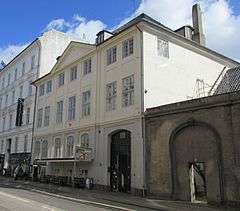Løve House
The Løve House (Danish: Løves Gård) is an 18th-century townhouse located at Bredgade 76 in the Frederiksstaden neighborhood of central Copenhagen, Denmark. It was listed on the Danish registry of protected buildings and places by the Danish Heritage Agency on 22 June 1991.
| Løve House | |
|---|---|
Løves Gård | |
 | |

| |
| General information | |
| Architectural style | Neoclassical |
| Location | Bredgade 76, Copenhagen |
| Country | Denmark |
| Coordinates | 55°41′13.67″N 12°35′36.68″E |
| Completed | 1757 |
| Owner | Jeudan |
History
Frederik Løve
The house (formerly Bredgade 183) was built in 1754–57 for customs appraiser Christian Frederik Løve.[1] It was conveniently located close to the Custom House.
The Wulff family and Hans Christian Andersen
A later resident was the navel officer Peter Frederik Wulff (1774-1842). He was head of the Navel Cadet Academy which was based in Frederick's Hospital from 1727 while its building was under renovation. The writer Hans Christian Andersen was a close friend of the Wulff family.[2] He lived with them for a while after for a few weeks returning from his first major journey abroad in 1834. He moved in on 10 August and moved to Nyhavn 20 (then Nyhavn 280) on 1 September.[1]
Later history
The Toro Oil Corporation Denmark Limited A/S was in the 1920s based in the building. It was owned by Carl F. Glad. He resided with his wife Grethe at Store Mariendal in Hellerup and was also the owner of the country house Rågegården in Rågeleje .[3] The company went bankrupt in connection with the Great Crash of 1929.[4]
The company M.B. Cohn A/S was later based in the building.[5] The company moved to new premises at Vallensbækvej 65 in 1981.[6]
The building was listed on the Danish registry of protected buildings and places by the Danish Heritage Agency on 22 June 1991.[7]
Architecture

The building has a simple, Neoclassical facade with a three-bay median risalit crowned by a triangular pediment. The two-bay gate opens to a long narrow courtyard. The side wing along its north side was originally two buildings but they were merged into one building in the 1820s. At thefar end of the courtyard is a former stable and carriage house.
Today
The building is today owned by Jeudan and has been converted into a 948 square metre office building.
Café Petersborg
The restaurant Petersborg is located in the cellar. In 1885 Hillary Clinton visited the restaurant as the guest of Lone Dybkjær during Bill Clinton's official visit to Denmark.[1]
References
- "Bredgade 76-76a-d" (in Danish). indenforvoldene.dk. Retrieved 22 March 2017.
- "H.C. Andersen og familien Wulff" (in Danish). Gads Forlag. Retrieved 22 March 2017.
- "Rågegården, Rågeleje". arkiv.dk (in Danish). Retrieved 29 January 2020.
- "Grethe Glad (1891 - 1990)". kvinfo.dk (in Danish). Retrieved 1 February 2020.
- "M.B. Cohn A/S" (in Danish). coneliand.dk. Retrieved 22 March 2017.
- "Fra teknisk lager til global koncern" (in Danish). Klinger Danmark. Retrieved 22 March 2017.
- "Sag: Bredgade 76" (in Danish). Kulturstyrelsen. Retrieved 22 March 2017.
External links
| Wikimedia Commons has media related to Løves Gård. |